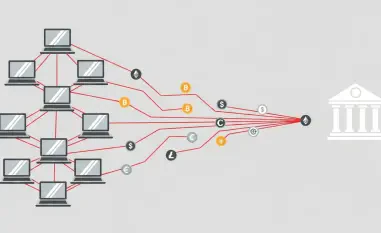The rise of Ransomware as a Service (RaaS) over recent years has brought about a dramatic shift in the cybercrime landscape, transforming the way malicious actors operate globally. RaaS streamlines the process for cybercriminals, turning complex ransomware attacks into a straightforward business service accessible even to those with limited technical expertise. This review aims to elucidate the operational mechanics and impacts of RaaS, offering insights into its evolving nature and implications for cybersecurity practices.
Understanding Ransomware as a Service
Ransomware as a Service simplifies the execution of ransomware attacks by offering an outsourced model where the creation, distribution, and management of ransomware are handled through service providers. RaaS typically comprises a subscription-based model that lowers barriers to entry for aspiring cybercriminals, effectively democratizing access to sophisticated ransomware tools. This evolution from traditional ransomware now enables individuals or groups lacking the expertise to launch attacks with minimal effort.
The concept of RaaS took root within the cybercrime ecosystem by adapting common SaaS business principles. By offering packages that include technical support, infrastructure, and maintenance, RaaS providers ensure that even novice attackers can capitalize on cyber vulnerabilities without requiring advanced coding skills. As a result, the appeal and proliferation of RaaS have grown, contributing to increased cyber risks globally.
Key Features and Working Mechanism of RaaS
Subscription-Based Model
Ransomware as a Service functions on a subscription-based model resembling legitimate SaaS businesses. Subscribers pay a recurring fee to access ransomware platforms that handle the attack’s deployment and extortion processes. The affordability and ease of use inherent in this model attract cybercriminals, enticing them with the promise of potentially lucrative returns against relatively modest investments.
Encryption and Decryption Services
RaaS providers offer robust encryption services, often employing advanced algorithms that render victim data inaccessible until a ransom is paid. Decryption services form the other half of the equation, presenting a unique challenge to cybersecurity professionals aiming to thwart ransomware attacks. The development of highly sophisticated encryption techniques enables RaaS operatives to maintain their hold over compromised systems, complicating efforts to reclaim data.
Emerging Trends in Ransomware as a Service
In the ever-shifting RaaS landscape, new strains and tactics are continually emerging, exemplifying the adaptive capabilities of cybercriminal enterprises. Recent observations reveal the introduction of Chaos—a new gang—in the wake of the dismantling of BlackSuit’s infrastructure. This emergence highlights the continual evolution and regrouping patterns within the underworld, fostering challenges for cybersecurity professionals to anticipate their next moves accurately.
The Chaos group’s tactics involve double extortion, with exorbitant ransom demands targeting high-profile organizations in the United States. Through the intricate exploitation of voice phishing and remote access tools, Chaos demonstrates a sophisticated understanding of network vulnerabilities, posing an elevated threat to entities globally.
Industry Impacts and Case Studies
The industries most susceptible to RaaS attacks include healthcare, finance, and critical infrastructure, sectors consistently targeted due to their high-value data and vulnerability to disruption. Prominent incidents showcase the extensive reach of RaaS prowesses—putting cybersecurity frameworks to the test and emphasizing the need for comprehensive security strategies.
High-profile organizational attacks, characterized by significant financial demands, underscore the severe implications for cybersecurity frameworks confronted by RaaS operations. These attacks necessitate a reexamination of existing protocols, urging organizations to adopt enhanced measures to combat evolving threats.
Challenges and Constraints Associated with RaaS
The proliferation of RaaS underscores formidable challenges concerning detection and prevention. The sophistication of techniques employed by RaaS providers often masks their activities, complicating efforts to detect and mitigate such threats. The ethical and regulatory dilemmas associated with widespread RaaS operations further stress the need for coherent frameworks aimed at curbing malicious actors.
Evolving cybersecurity practices face barriers in adequately addressing the versatility of RaaS, prompting urgent considerations around cross-border cooperation and stringent regulations to stem its growth. Despite advancements in cybersecurity measures, the persistent adaptability of ransomware groups demands ongoing vigilance.
Prospective Developments in Ransomware as a Service
Examining future trends reveals anticipations of increased RaaS sophistication due to technological advancements and heightened evasion capabilities. Strategies aimed at counteracting RaaS growth focus on intelligence sharing, public-private cooperation, and the development of advanced threat detection tools.
As RaaS advancements continue, potential defense mechanisms evolve, harnessing machine learning and AI capacities to predict and thwart ransomware operations proactively. Collaborative efforts across borders may bolster the cybersecurity community’s ability to navigate the complexities presented by future RaaS developments.
Observations and Insights
Ransomware as a Service has fundamentally altered the cybersecurity domain, proving to be a persistent threat amid ongoing technological innovations. Its democratization within cybercrime emphasizes the urgency for enhanced defense mechanisms and international collaboration. Despite recent regulatory improvements, the continuously evolving face of RaaS demands vigilance and proactive adaptation from cybersecurity sectors, ensuring preparedness for forthcoming developments.













